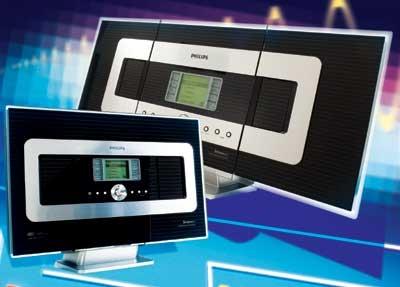The Connected House: Room Service

Both Sony and Philips are similarly large and have similar histories of innovation, but their respective approaches to whole-house entertainment couldn't be more different. While Philips has focused on easy-to-use gear that lets you move digital music files around the house, Sony is offering A/V products that deliver a lot of the power and functions of high-end custom systems but without their complexity and hefty price tags. To get a sense of how well each company is rising to the challenge of the connected house, I checked out Philips's forthcoming WACS700 Wireless Music System and Sony's CAV-M1000ES A/V distribution system.
Philips Goes Wireless The elegantly styled, Wi-Fi-enabled WACS700 Wireless Music System ($999) comprises the Music Center base station with a top-loading CD player and a 40-gigabyte (GB) hard disk plus a smaller satellite Music Station. The base station, where you rip and store CDs (no computer needed), has a two-way infrared (IR) remote, while the satellite has a conventional remote. You can use up to five satellites ($299 each) to access and play music stored on each base station. Instead of conventional speakers, both components use what Philips calls Super Sound Panel technology, where an exciter is attached to a flat surface to turn it into a sound radiator. The base station's back panel has an Ethernet port for connecting it to a PC or Mac, plus auxiliary inputs and outputs.
To rip a CD, you simply drop it into the slot on the base station. When ripped at the default MP3 rate of 128 kilobits per second (kbps), there's enough room on the hard drive for about 750 CDs. For better sound, you can rip tracks at up to 320 kbps, but the hard drive will fill up faster. The system also supports WAV and WMA files, but not copy-protected WMA files, and comes with Gracenote's database for displaying artist, album, and song information. If you hook up the Music Center to a computer, you can download database updates. Philips will also send out quarterly updates on CD-ROM. The Music Center's LCD screens give you a number of ways to categorize and search for tracks, including by song, artist, album, and genre.
In many ways, the WACS700 is for people who either don't own a PC or who don't want to use one as a media server. But computer owners can link their PC-based music libraries to the base station via the wired Ethernet port or by streaming tunes wirelessly to the base station using the system's 54-megabits-per-second (Mbps) 802.11g Wi-Fi network (this assumes that the PC and the Music Center are on the same network).
- Log in or register to post comments



































































